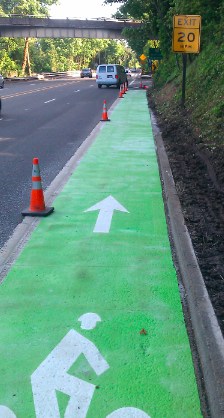
(Photo: Alan Love)
I’ve got a couple of news tidbits from the Oregon Department of Transportation (ODOT) that have piled up in my inbox so I thought I’d share them all at once. From a new job opening in their Active Transportation section to the installation of their first-ever green colored bikeway, the agency continues to show positive progress.
First, according to a reader who rides on SW Barbur everday, the Oregon Department of Transportation has just completed the main part of their Barbur Blvd Bike Improvement Project (a project we shared more about back in March). Reader Alan Love reports that ODOT has added green coloring the southbound bike lane on Barbur Blvd. that leads to the Beaverton-Hillsdale Highway turnoff.
Here are two photos of the new markings sent in by Alan…
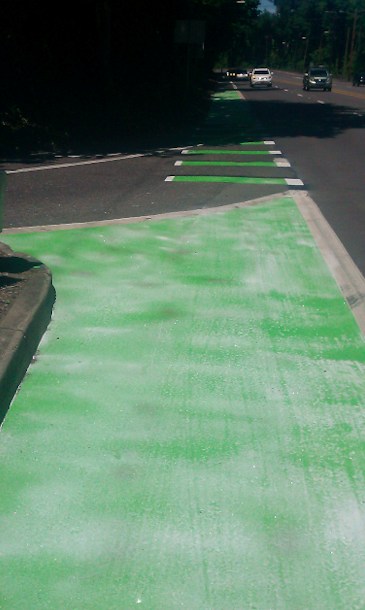

Speaking of ODOT’s active transportation priorities; the agency has just posted a major job opening titled, Operations and Policy Analyst 3 (Transit & Active Transportation Liaison). The description calls for someone to, “lead ODOT’s participation in all transit, bike and pedestrian project development and coordination activities within Region 1” (Region 1 is Portland’s region.) The person will also, “Research innovative options for active transportation projects, and help refine projects to better meet ODOT and partner needs” and “Manage research, analysis or projects related to ODOT’s role in Active Transportation in the Portland Metropolitan Region.”
To my knowledge, this is a new position that hasn’t existed in the past. This is likely to be an important cog in the wheel at ODOT and whoever gets the position will be poised to have real influence over how the agency moves forward in biking, walking, and transit. Please spread word of this position and have all of your smartest friends apply.
And finally today, I want to share a comment from ODOT Director Matt Garrett. As you might recall, I recently reported on a proposal from ODOT’s Motor Carrier Division that would have given freight interests overwhelming power in Oregon. As part of my research for that story, I asked Garrett a few questions via email. He didn’t respond quickly enough to be in my story; but I wanted to share one of his responses I just received.
I asked Garrett if his decision to suspend new guidelines for the implementation of ORS 366.215, and begin a “collaborative” new rule-making process for it, was related to his efforts to build a better active transportation network in Oregon. Here’s how he answered:
“Yes, I would say that it is related, in part, to ODOT’s commitment to active transportation, but there are many factors at play. ODOT is committed to both helping communities create and maintain active transportation networks, and preserving the ability of trucks to move on our highways. To achieve these goals ODOT is committed to trying to resolve potential conflicts between freight and active transportation.
A driver in creating ODOT’s new Active Transportation section was to integrate programs and funding sources to support the selection and delivery of projects that are multidimensional transportation projects, providing complete transportation solutions for communities. The ORS 366.215 discussion is a great example of how the transportation system is a complex, multi-modal transportation system with inherit conflicts. ODOT is in a unique position in that it operates state highway system in which national and international companies rely to move goods as part of their day-to-day operations. At the same time, ODOT has an obligation to all users of the larger transportation system – bike, pedestrian and transit – to provide safety and reliability. For example, I like to buy apples at the Sellwood New Seasons [Garrett lives at SE 42nd and Flavel]. In terms of transportation, this raises many questions: How does my apple get from the orchards in Hood River to New Seasons? Does Oregon’s freight network allow for enough mobility to truck the apple in a timely manner so its still fresh when it arrives at the store? Does it do so in a way that doesn’t compromise the needs of the local system? Will that truck that delivers the apples be on the same road as the sidewalk that I use to walk to the store? Does that truck route and my pedestrian route overlap near the store? You can see where I am going with this. There are inherent conflicts in the system, and one of ODOT’s roles to to balance many factors and come up with the best solutions possible.”
I realize Garrett tends to be somewhat verbose; but when you consider where ODOT is coming from and the bureaucratic constraints he’s operating under, it seems he’s sincerely trying to change the agency for the better (his unabashed support for the Columbia River Crossing notwithstanding). To continue on this path, to do more projects like the one on SW Barbur, and to fight off forces from within his own agency to maintain the auto and truck-centric status quo, Garrett will need all the pro-bike/transit/walking staffers he can muster.



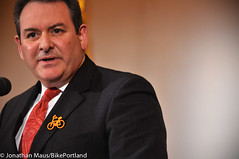
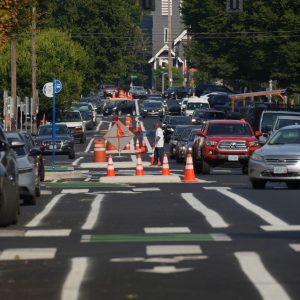

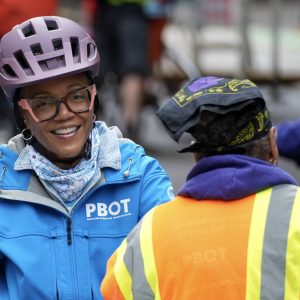
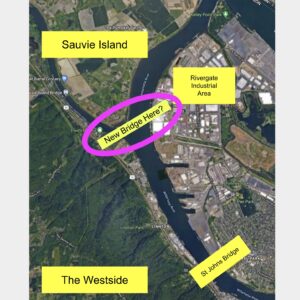
Thanks for reading.
BikePortland has served this community with independent community journalism since 2005. We rely on subscriptions from readers like you to survive. Your financial support is vital in keeping this valuable resource alive and well.
Please subscribe today to strengthen and expand our work.
Dear ODOT,
Please [consider] add a few RRPMs along the lane line of the new green bike lane…just for improved night time/ low visibility delineation of the lane. It may also help reduce motor vehicle wear on the lane line. Thanks.
As noted, the new green bike lanes on Barbur at Capitol Highway on Thursday and Friday, June 14 – 15. The first ever green thermo plastic on a state highway in Oregon!
Some people to thank for making this happen, with apologies to those not listed:
Jeff Moss, ODOT Project Manager
Robert Hopewell, ODOT Traffic Engineer
Shelli Romero, ODOT Public Involvement
Kiel Johnson, Friends Of Barbur – (facebook)
Marianne Fitzgerald, SW Neighborhoods, Inc Board President
Roger Averbeck, SWNI Transportation Committee
I would like to hear from you on how the new facility is working, or not working…
Transportation@swni.org (Roger Averbeck)
awesome change, thank you!
It’s heartening to see this small change in the right direction for ODOT.
One minor quibble with the apples example is that apples are rarely fresh at New Seasons or any other grocery store. They are picked over a short time when they’re ripe and put in cold storage then sold year round. If you’re buying apples now they are either from south of the equator or have been in cold storage for many months.
My point being we don’t really need trucks to move apples to market quickly.
Currently the quickest way to move apples in to this region is by truck only from origin to destination. Sadly it may also be the most fuel efficient. As well.
If one only considers the fuel cost per ton/mile a multimodal approact, truck to local rail depot to destination local rail depot and truck to final desination, then our rail system is the best way to go.
For cargo requiring refrigeration speed is still our friend. You see the refrigeration units, reefers, run on diesel. A 2 day trip by truck can easily be a 5-7 day trip by train excluding the truck trip at either end. All that time on the rails the reefer drinks a prodigious amount of fuel.
The system we have is by far not the best (see underground freight networks and vactrain) but it is the most economically efficient. If you wish to affect the user mix attempt to influence the cost of travel so the target becomes too expensive.
In respect to your comment apples then make the perfect example for examining the priorities of our transportation spend.
That is, we’re presented with the apple as the reason why growing expenditure and priority of access for the freight industry must continue to be built into our local transportation infrastructure at the expense of individual safety and mobility, when in fact, it’s a smokescreen designed to scare us, because as you pointed out, it’s actually a non issue.
I’m willing to give the speaker the benefit of the doubt that this was simply a bad example (rather than a deliberate ruse) but it illustrates why claims like “it’s the economy stupid” must be questioned rather than simply accepted at face value just because we’re in an economic downturn.
And the cold storage is why their apples often smell like mildew.
Hmmm…I wonder if those traffic cones could be turned into bollards that would physically (somewhat, anyway) prevent cars from spilling over into this beautiful bike lane. At the very least, such barriers would make drivers slow down, put their cell phones down for once, and pay a huge amount of attention to this car-restricted zone. Otherwise, it’s simply too easy to not pay attention and wander into the bike lane.
This change is beautiful, but (without meaning to sound negative, which is a real challenge when making this comment–sorry!) it’s still a painted lane. Probably ALL of us that follow bikeportland.org are comfortable riding on this or any other street, but this still fails to address the “other 90%” of the population that requires totally safe, separate facilities.
This is a wonderful start, but we won’t even begin to approach a 5% bike mode split in the suburbs or 25% in Portland without a fully integrated network of bike trail corridors. I know I’m a little off-topic, though. Again, sorry about that. 🙂
I still love the University Avenue bike lane at UW-Madison more than any other cycle track in the U.S. It was completed in the 1970’s, and there’s still nothing else that compares. It’s used by countless thousands of cyclists every day just on its mere half-mile-long (?) length.
Again, I’m not complaining–just pointing out that we must continue to look outside this (mostly) bike-anywhere-with-no-fear-or-problems group to the larger population, so that we can make a multi-billion-dollar difference in how we transport ourselves as a metro area. Also, any progress is wonderful–huge thanks to so many people for working tirelessly on our behalf!! Especially Jonathan, of course. 🙂
Agreed the SW hills are a disaster and terrified my wife every time she tried to take the Barbur route to get to work. Terwiliger is nice, but really out of the way to getting to downtown (plus more additional uphills)
Tim has a good question about the bollards. I see a lot of vehicles driving in and on the lane lanes. This appears to wear them out which cost money to re-stripe. If not bollars how about some enforcement?
Much thanks to the group that made this happen. I emailed some feedback to the email address below. Nice to see some action. Good work.
Green paint and more of it….What’s sustainable about painting and repainting black asphalt green?
Drove past the new lane this morning. Looks impressive. I’ll try to watch other vehicles and see if it is making people more observant.
I drive in that area several times a week and often saw people cutting into the bike lane while making that right turn from Barbur to Capitol Hwy. I think it’s gotten a lot better since the green lane was installed. I agree that some reflectors would make it even better.
This Coating gets Slick when wet?
I rode the Barbur lane yesterday with a bit of drizzle and it felt nice n’ grippy. Thermoplastic isn’t paint, and it has a bit of a rubbery texture so it isn’t slick. I took those photos with a cell camera, so it doesn’t show off the lane well with the contrast of sun/shadow. It’s actually quite bright, and the interrupted section across the slip lane is pretty visible. My only worry is that over time some of the dashes will wear down as the previous white dashes did. The un-interrupted section before the turn off will probably last decades, but hopefully ODOT will continue to maintain the dashed area. Jerks will always be jerks, so we still have to be aware, but hopefully this sends the message to the “Undecided” that through-traffic (i.e. cyclists) has the right-of-way over turning traffic.
It’s uphill, so grip shouldn’t be too much of an issue.
The cross bike where the lane passes by the turn onto Capitol Hwy is going to wear out pretty fast since they didn’t orient it to align with the auto path. Otherwise, it’s progress.
Oh thank goodness, a green bike lane! Those magically protect people on bicycles.
/sarcasm
This is a big improvement over an extremely dangerous and unpleasant baseline – well done ODOT! I still don’t think I’d ride on this facility, but this section now looks accessible to some of the more confident “enthused and confident” folks.
I would probably ride it if I needed to, since I’ve ridden on the fog line on rural highways, such as 18 and 22 before.
SW hills need a lot of love, tho. When is the SW Capitol highway project going to happen?
Where’s the sidewalk? Are you suposed to walk in the bikelane?